

Newsletter Creator, Web Page Builder, Bookmarker. 8 Chrome Extensions That can Help You in Content Curation. Are you in search of some really good Chrome Extensions that will help you in content creation and curation and make your work a lot more simplified?

If yes, then probably you have come to the right place. With so much software and extension options available, it can get very difficult to find a perfect fit. Here I am going to enlist 8 chrome extensions that can prove to be really helpful for you, save your time and manual efforts, and most importantly save you from searching or hunting for these when you have got so much other important stuff to do already! So, let’s get started! Pocket Pocket comes very handy when you find something important but want to view it later, so you just put it in ‘Pocket’. It is available in both free and premium versions. What’s special about Pocket: 2. AllTabs helps you manage your tabs in Chrome. Features of AllTabs: 3. SimilarSites helps you discover sites which are similar to the ones you already know and love.
What’s special about SimilarSites: Au.pcmag. Let's talk about Google Keep.
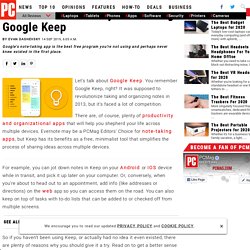
You remember Google Keep, right? It was supposed to revolutionize taking and organizing notes in 2013, but it's faced a lot of competition. There are, of course, plenty of productivity and organizational apps that will help you shepherd your life across multiple devices. Evernote may be a PCMag Editors' Choice for note-taking apps, but Keep has its benefits as a free, minimalist tool that simplifies the process of sharing ideas across multiple devices. Some of The Best Digital Curation Tools for Teachers. October 3, 2017 A few days ago, we featured 4 good web tools to help teachers and educators make the best of their collaborative team work and today we are re-featuring a collection of some of the best bookmarking tools out there.
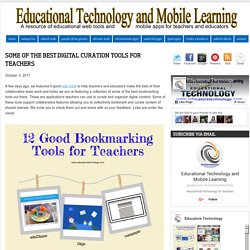
These are applications teachers can use to curate and organize digital content. Some of these tools support collaborative features allowing you to collectively bookmark and curate content of shared interest. We invite you to check them out and share with us your feedback. Links are under the visual. 1- eduClipper ‘Clip items from the web, upload your own work, or find and re-clip content from others to customize and maximize your learning.’ 2- Diigo Diigo is ‘save and tag your online resources for easy access anytime, anywhere. 3- Instapaper ‘Save all of the interesting articles, videos, cooking recipes, song lyrics, or whatever else you come across while browsing. 7- Trello Trello allows you to organize and manage your projects in effective ways.
5 content curation examples so good they'll make you jealous - Scoop.it Blog. You know how “a picture is both a thousand words”, right?
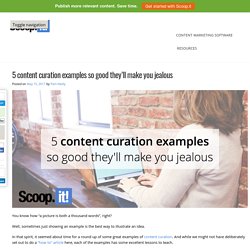
Well, sometimes just showing an example is the best way to illustrate an idea. In that spirit, it seemed about time for a round up of some great examples of content curation. And while we might not have deliberately set out to do a “how to” article here, each of the examples has some excellent lessons to teach. These are companies and publications that don’t just aggregate content – they add their own commentary and spin to what they curate. Every edition of their newsletter, every blog post, every social media share is chosen for a specific purpose and reviewed by a human before it is shared.
In other words, these sources curate their content like museum curators. Curation in Learning. I’m getting very excited about the possibilities of using more digital curation in learning.
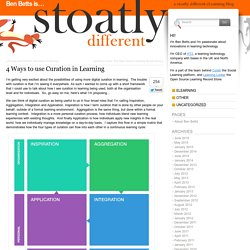
The trouble with curation is that I’m seeing it everywhere. As such I wanted to come up with a short framework that I could use to talk about how I see curation in learning being used, both at the organisation level and for individuals. So, go easy on me; here’s what I’m proposing… We can think of digital curation as being useful to us in four broad roles that I’m calling Inspiration, Aggregation, Integration and Application. Inspiration is how I term curation that is done by other people on your behalf, outside of a formal learning environment. Inspiration With the proliferation of content on the Web, it should come as no surprise that we are in increasing need of systems to sort, maintain and re-purpose content in a systematic manner.
Organizations can of course benefit from this approach. Aggregation Increasingly we are being challenged to deliver ‘more with less’ in the learning department. Content Curation & Fair Use: 5 Rules to being an Ethical Content Curator. * Update: I have a much lengthier updated post that incorporates the material below: Content Curation: Copyright, Ethics, & Fair Use Recently, Kimberley Isbell of the Nieman Journalism Lab cited a Harvard Law report and published an extensive post on news aggregation and legal considerations.

From a curation perspective, the whole article is interesting, but what was the most surprising was that her recommendations for being an ethical content aggregator, were the same as being an effective content curator. The five recommendations are below. You can read the full article for the legal justifications for abiding by these practices. However, I have provided some reason on why you would want to follow these guidelines from a content marketing perspective: 1. Marketing reason: The more you link to third parties, the more likely they are to link back to you – which ultimately improves your SEO. 2. 3. 4. 5. *Disclaimer: I am not a lawyer. A framework for content curation. In conversation at EduTECH earlier this month, Harold Jarche evoked George E.
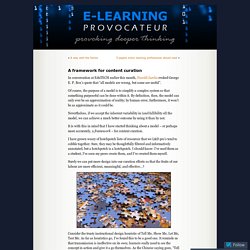
P. Box’s quote that “all models are wrong, but some are useful”. Of course, the purpose of a model is to simplify a complex system so that something purposeful can be done within it. By definition, then, the model can only ever be an approximation of reality; by human error, furthermore, it won’t be as approximate as it could be. PearlTrees Tutorial Part 1. Tweet pearltree. Pearl Tree Tutorial. How To Create A Pearltree And Add A Pearl. Pearltrees Tutorial. Tutorials.